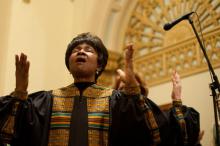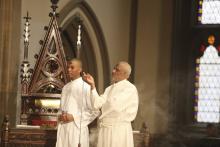Ministry

ART CONSERVATIONALISTS RECENTLY discovered a previously unknown Vincent van Gogh painting, a rare find that has excited the art world. On the back of his 1885 portrait “Head of a Peasant Woman,” tucked beneath layers of cardboard and glue, is a hidden self-portrait from early in van Gogh’s career, before he famously cut off his left ear. But the discovery is significant for more than its artistic importance. The hidden self-portrait is symbolic of van Gogh’s larger life and works, illustrating his Christian faith, compassion for the poor, and lifelong struggle with religious rejection.
Van Gogh grew up attending church and wanted to become a clergyman, just like his father, Rev. Theodorus van Gogh. But these hopes were dashed when he was unable to enter religious studies, in part because of behavior considered “eccentric” — a sort of manic shifting of interests. This was an early manifestation of van Gogh’s lifetime of mental health struggles, and the beginning of a complicated relationship with the church.

Black women have been historically marginalized both in the church and society — and this trend continues today in theological education as well as the church. Neither the church nor the world of theology will survive if things continue in this direction.

The Bible has more to say about women in leadership positions than we are often led to believe, and with the exception of that pesky little 1 Timothy passage, the biblical narrative about women leaders is overwhelmingly positive. Let’s take a look at 10 examples.

Why split public and societal critique from personal care and comfort? Whose ends does this split serve?

On September 11th, 2001, while walking my dogs over to the Hudson River in the Greenwich Village where I lived, I heard the sound of two low-flying planes. I then witnessed everything that happened, standing there with my neighbors in utter, total disbelief.

When I heard that Rev. Butler was appointed the first woman pastor of Riverside, I thought she broke the stained-glass ceiling. Instead, the church threw her off the stained-glass cliff. The phenomenon of the glass cliff is one documented throughout the working world. Women are invited into senior-level leadership only at times of crisis, when intractable problems, often caused by male predecessors, cannot be solved. There’s nothing to lose because things have hit rock bottom.

A direct reboot of Bravo’s Queer Eye for the Straight Guy, which debuted in 2003, Queer Eye is, on its surface, a makeover show in which five gay men –– Jonathan Van Ness, Tan France, Antoni Porowski, Karamo Brown, and Bobby Berk –– help transform their clueless subject, or “hero,” in five areas: grooming, fashion, food, culture, and home decor. But each episode becomes more than a makeover as the men of that Fab Five break through the hero’s walls and reach the root of their low self-esteem. That’s where the true emotions rise to the surface.

R. Marie Griffith, director of the John C. Danforth Center on Religion and Politics at Washington University in St. Louis, said that the Assemblies of God, founded in 1914, has had a “fascinating history” of women’s leadership, with women leading congregations and speaking from pulpits in its early days and later often finding their roles restricted.

Growing up, I heard stories about random acts of kindness, anonymously dropping off gifts for people, blessing them in some way as to remind them that they are not alone. It was almost a Christian duty to spread kindness like this, because it was kindness without expecting anything in return. I thought about doing that for these neighbors, leaving a simple note or just a bouquet on their doorstep, but that’s not what was needed. In all that may have been awkward or uncomfortable about that encounter, these people needed to know that I saw them.

We are steeped in a culture that celebrates endless work and the denial of one’s own health. Christian faith leadership demands a counter-witness. Ministry life should reflect a theology of service and commitment both to God and other people, but it should also embody healthy balance and spiritual sustainability for the long work of learning faith and reflecting God’s grace to a world hungry for it.

In January 2016, the Rev. Cynthia Meyer told her United Methodist Church congregation she felt “called by God to be open and honest” about who she is: “a woman who loves, and shares her life with, another woman.”

THE ROLE AND identity of the minister has always been complex: Preacher and teacher, pastor and prophet, counselor and social worker. Despite this inherent dynamism, church structures—seminaries, congregations, denominations—often focus on transforming diverse candidates for ministry into a uniform class of spiritual professionals equipped to serve Christ in a bygone era. Responding to the challenges facing congregations today involves hearing and sharing the gospel in fresh ways, which requires a revolution in how ministers understand themselves and the training they receive.
Cynthia G. Lindner’s Varieties of Gifts does not read like a revolutionary text, but it is iconoclastic. While Lindner does not argue directly with the many books on pastoral leadership encouraging conformity to a specific mold, she gently brushes them away with a thoroughly postmodern conception of the “well-lived pastoral life.” Drawing on insights from dialogical psychology, which highlights the “multiplicity” of the human self, Lindner brings attention to the diverse talents and perspectives of aspiring and seasoned pastors. Too often this plurality is perceived as vocational ambivalence or personal confusion—an obstacle to be overcome in the modern quest to create a unified, coherent sense of self. Yet this pursuit of a single identity deprives ministers of important resources, limiting both their professional effectiveness and satisfaction.
Varieties of Gifts seeks to end this repression and embrace the minister’s natural multiplicity. Lindner believes this path leads to the realization of untapped potential at a moment when religious institutions are desperate to discover new and different ways of being faithful. She writes, “effective ministers have always inhabited plural roles and multiple selves which have funded the flexibility and inventiveness that religious leadership demands over the long haul.” Thus, the internal tensions of the minister’s life (How do I serve this community as both prophet and priest? How do I remain authentic while embodying a role defined by perception?) become a resource in the pursuit of excellence rather than a distraction that promises to lead one astray.

Clergy have long been expected to be paragons of piety and purity. As public religious figures, we’re assumed to represent the moral ideal — an example for others to follow — and as a result, we become archetypes rather than human beings. We are measured up against an image of what a perfect Christian pastor should look like.

The couple has found that part of their calling in these schools is not just to the children, but also to the teachers who serve those children. Cheryl has taken to performing regular acts of kindness for the teachers — showing up in the teachers’ lounge with a plate of cookies, or stopping by the main office to give a hug to the administrator in charge of discipline.
“I tell her, ‘I’m sure you’ve had a rough day today. Can I give you a hug?’ I just never knew it would make such a difference. [They] feel so supported,” said Cheryl.

Your pastor doesn't have it all figured out. We promise.
They get scared. They get angry. They get lonely. And they doubt whether any of it's worth their time, or their faith.

Faith-based food trucks are building momentum across the country. In St. Paul, Minn., Lutheran pastor Margaret Kelly’s church is actually a food truck, providing free food and prayers to homeless and impoverished members of the community.
Back in Texas, the Chow Train in San Antonio has been making national headlines for fearlessly serving homeless residents despite a $2,000 fine in April for serving food from the back of a private vehicle.

St. Mary’s Cathedral in San Francisco is getting bad press this week over a sprinkler system it installed to keep homeless people from sleeping on church grounds.
People are outraged that a church would treat the poor so callously. But St. Mary’s isn’t alone. Many houses of worship all over the country face the question of how to keep safe, welcoming grounds while being compassionate to homeless neighbors sleeping on porches and in doorways.
Here’s what we tried at Mount Vernon Place United Methodist Church in Washington, D.C.
A couple of months ago, we started a dialogue around how to move people off the porches of the church and assist them in moving on. Over the years, the protected and secluded porches had become sleeping quarters for a dozen or so folks, and it was now out of hand. People were using the grounds as bathroom facilities; others were leaving their belongings in plastic-covered 4-foot high mounds.
The conversation, held in a church committee meeting in January, was contentious.

I was among millions across the globe wrapped up in the glee of Pharrel William’s song, “Happy.” I first heard it while watching Despicable Me 2 with my family last year. As the credits rolled I remember making a mental note to add it to my workout playlist.
Pharrel even released a 24-hour video of the song on YouTube for millions to enjoy globally – creating a sort of time released happy capsule that was just a click away.
I thought about how this “Happy” anthem struck a chord in our world’s collective unconscious. “Could it be a sign that all of us, the human family, crave deeper joy and some levity?”
I think faith-based communities can discuss this for years to come at a time where joy is a necessity more than a luxury, and ministers are flaming out quicker than ever, and according to a New York Times article, suffer from depression “at rates higher than most Americans.”
Maintaining a sense of joy is then vital for my own work, especially since I lean toward New York-bred cynicism and incredulity. Activism can be rewarding, yet also extremely discouraging at times. Change can seem incremental at best, and the issues are much bigger than any one person or institution can handle. Making joy a vital ingredient in the active life of faith, within the soul of activity.
I’ve been considering three approaches in cultivating joy, a God-given, buoyant energy, in the midst of some weighty work.

To a Dying Church,
Guess what? It’s not that bad.
You just have to get it together a bit.
Seriously, like yesterday. I mean, we have time. But, seriously, we’re all waiting for you to get it together.
You have the means. You have the ability. You have the know-how.
Actually, you don’t have to do that much. You just have to realize that Jesus has done it all and there is a current of immense possibility right under your feet.
Tap into it. Remember it. Root down.
This happens every so often. We are cyclical people. Every once in a while we forget.
But this time you’ve really done a doozy on your own health by chasing after insane supplements and growth hormones. And you’ve also picked some really lame fights. In the race to grow you’ve forgotten your way a bit and now you’re bloated and punch-drunk in the streets swinging at anyone that’ll ask a sensible question.
Stop it. You’re better than this.

Son of God is Hollywood’s take on the life and teachings of Jesus of Nazareth. While the producers clearly tried hard to use modern filmmaking techniques to bring scripture to the big screen, the attempt fell flat somewhere between the use of action-sequences, swelling music reminiscent of old Westerns, and unconvincing acting — Jesus is played by Portuguese actor Diogo Morgado, who managed to look irritatingly self-satisfied for most of the movie.
Since faith is such a personal, spiritual experience, it begs the question: Is it possible to make the life and ministry of Jesus into a film that accurately reflects Christianity, or does such an effort cheapen beliefs?